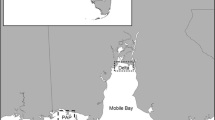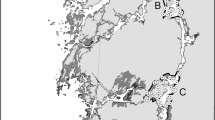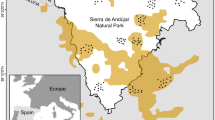Abstract
Investigating predator–prey relationships is an important component for identifying and understanding the factors that influence the structure and function of ecosystems. Mesopredators, defined as mid-level predators, have a profound effect on ecosystem structure by contributing an important link between apex predators and lower trophic levels. The diet of two elasmobranch mesopredators, Squalus acanthias and Mustelus antarcticus, was investigated in three locations in south-east Tasmania. Squalus acanthias consumed predominantly pelagic teleosts and cephalopods, while M. antarcticus predominantly consumed benthic crustaceans. As a result, there was low dietary and niche overlap between the two species. There was however evidence of intra-specific dietary variations between locations for both the species. This study has contributed to a better understanding of the top-down dynamics of the food web in coastal Tasmania, by providing important dietary information of two abundant mesopredators. In addition, the similar dietary patterns for S. acanthias and other Mustelus species over much of their global range suggest they may be consistent in their trophic roles across systems, with limited competition between these two sympatric mesopredators to be expected.





Similar content being viewed by others
References
Abrantes KG, Barnett A (2011) Intrapopulation variations in diet and habitat use in a marine apex predator, the broadnose sevengill shark Notorynchus cepedianus. Mar Ecol Prog Ser 442:133–148. doi:10.3354/meps09395
Amundsen PA, Gabler HM, Staldvik FJ (1996) A new approach to graphical analysis of feeding strategy from stomach contents data—Modification of the Costello (1990) method. J Fish Biol 48:607–614. doi:10.1111/j.1095-8649.1996.tb01455.x
Avsar D (2001) Age, growth, reproduction and feeding of the Spurdog (Squalus acanthias Linnaeus, 1758) in the south-eastern black Sea. Estuar Coast Shelf Sci 52:269–278. doi:10.1006/ecss.2000.0749
Barnett A, Semmens JM (in press) Sequential movement into coastal habitats and high spatial overlap of predator and prey suggest high predation pressure in protected areas. Oikos. doi: 10.1111/j.1600-0706.2011.20000.x
Barnett A, Abrantes KG, Stevens JD, Bruce BD, Semmens JM (2010a) Fine-scale movements of the broadnose sevengill shark and its main prey, the gummy shark. PloS ONE 5:e15464. doi:10.1371/journal.pone.0015464
Barnett A, Abrantes K, Stevens JD, Yick J, Frusher SD, Semmens JM (2010b) Predator-prey relationships and foraging ecology of a marine apex predator with a wide temperate distribution. Mar Ecol Prog Ser 416:189–200. doi:10.3354/meps08778
Barnett A, Redd KS, Frusher SD, Stevens JD, Semmens JM (2010c) Non-lethal method to obtain stomach samples from a large marine predator and the use of DNA analysis to improve dietary information. J Exp Mar Biol Ecol 393:188–192. doi:10.1016/j.jembe.2010.07.022
Baum JK, Worm B (2009) Cascading top-down effects of changing oceanic predator abundances. J Anim Ecol 78:699–714. doi:10.1111/j.1365-2656.2009.01531.x
Belleggia M, Figueroa DE, Sánchez F, Bremec C (2011) The feeding ecology of Mustelus schmitti in the southwestern Atlantic: geographic variations and dietary shifts. Environ Biol Fish. doi:10.1007/s10641-011-9874-3
Blackburn M (1950) A biological study of the anchovy, Engraulis australis in Australian waters. Mar Freshw Res 1:3–84
Braccini JM, Gillanders BM, Walker TI (2005) Sources of variation in the feeding ecology of the piked spurdog (Squalus megalops): implications for inferring predator-prey interactions from overall dietary composition. ICES J Mar Sci 62:1076–1094. doi:10.1016/j.icesjms.2005.04.004
Clarke KR, Gorley RN (2001) Primer v5. PRIMER-E, Plymouth, p 91
Coleman N, Mobley M (1984) Diets of commercially exploited fish from Bass Strait and adjacent Victorian waters, south-eastern Australia. Aust J Mar Fresh Res 35:549–560. doi:10.1071/MF9840549
Collins AB, Heupel MR, Hueter RE, Motta PJ (2007) Hard prey specialists or opportunistic generalists? An examination of the diet of the cownose ray, Rhinoptera bonasus. Mar Freshw Res 58:135–144. doi:10.1071/MF05227
Cortés E (1997) A critical review of methods of studying fish feeding based on analysis of stomach contents: application to elasmobranch fishes. Can J Fish Aquat Sci 54:726–738. doi:10.1139/f96-316
Costello MJ (1990) Predator feeding strategy and prey importance—a new graphical analysis. J Fish Biol 36:261–263. doi:10.1111/j.1095-8649.1990.tb05601.x
Demirhan SA, Seyhan K, Basusta TN (2007) Dietary overlap in spiny dogfish (Squalus acanthias) and thornback ray (Raja clavata) in the southeastern black sea. Ekoloji 16:1–8
Elmhagen B, Rushton SP (2007) Trophic control of mesopredators in terrestrial ecosystems: top-down or bottom-up? Ecol Lett 10:197–206. doi:10.1111/j.1461-0248.2006.01010.x
Estes JA, Tinker MT, William TM, Doak DF (1998) Killer whale predation on sea otters linking oceanic and nearshore ecosystems. Science 282:473–476. doi:10.1126/science.282.5388.473
Gotelli NJ, Entsminger GL (2011) EcoSim: null models software for ecology. Version 7. Acquired Intelligence Inc. & Kesey-Bear. Jericho, VT 05465. http://garyentsminger.com/ecosim.htm
Hanchet S (1991) Diet of spiny dogfish, Squalus acanthias Linnaeus, on the east coast, South Island, New Zealand. J Fish Biol 39:313–323. doi:10.1111/j.1095-8649.1991.tb04365.x
Heithaus MR (2004) Predator-prey interactions. In: Carrier JC, Musick JA, Heithaus MR (eds) Biology of the sharks and their relatives. CRC Press, Florida, pp 487–523
Heithaus MR, Frid A, Wirsing AJ, Worm B (2008) Predicting ecological consequences of marine top predator declines. Trends Ecol Evol 23:202–210. doi:10.1016/j.tree.2008.01.003
Henderson AC, Dunne J, Flannery K (2002) Stomach contents of spiny dogfish Squalus acanthias L. off the west coast of Ireland. Ir Nat J 27:101–105
Hobday DK (1992) Abundance and distribution of pilchard and Australian anchovy as prey species for the little penguin Eudyptula minor at Phillip Island, Victoria. Emu 91:342–354. doi:10.1071/MU9910342
Holden MJ (1966) The food of the spurdog, Squalus acanthias (L.). J Cons Int Explor Mer 30:255–266. doi:10.1093/icesjms/30.2.255
Hutchins B, Swainston R (1993) Sea fishes of southern Australia. Swainston Publishing, Australia, p 180
Huveneers C, Otway NM, Gibbs SE, Harcourt RG (2007) Quantitative diet assessment of wobbegong sharks (genus Orectolobus) in New South Wales, Australia. ICES J MarSci 64:1272. doi:10.1093/icesjms/fsm111
Hyslop EJ (1980) Stomach contents analysis- a review of methods and their application. J Fish Biol 17:411–429. doi:10.1111/j.1095-8649.1980.tb02775.x
Jones BC, Geen GH (1977) Food and feeding of spiny dogfish (Squalus acanthias) in British Columbia waters. J Fish Res Board Can 34:2067–2078. doi:10.1139/f77-274
Kamura S, Hashimoto H (2004) The food habits of four species of triakid sharks, Triakiss cyllium, Hemitriakis japanica, Mustelus griseus and Mustelus manazo, in the central Seto Inland Sea, Japan. Fish Sci 70:1019–1035. doi:10.1111/j.1444-2906.2004.00902.x
Koen Alonso M, Crespo EA, Garcia NA, Pedraza SN, Mariotti PA, Mora NJ (2002) Fishery and ontogenetic driven changes in the diet of the spiny dogfish (Squalus acanthias), in Patagonian waters, Argentina. Environ Biol Fish 63:193–202. doi:10.1023/A:1014229432375
Krebs CJ (1999) Ecological methodology, 2nd edn. Addison-Welsey Educational Publishers, California, p 624
Laptikhovsky VV, Arkhipkin AI, Henderson AC (2001) Feeding habits and dietary overlap in spiny dogfish Squalus acanthias (Squalidae) and narrowmouth catshark Schroederichthys bivius (Scyliorhinidae). J Mar Biol Ass UK 81:1015–1018
Last PR, Stevens JD (2009) Sharks and rays of Australia. CSIRO Publishing, Melbourne, p 656
Lucifora LO, García VB, Menni RC, Escalante AH, Hozbor NM (2009) Effects of body size, age and maturity stage on diet in a large shark: ecological and applied implications. Ecol Res 24:109–118. doi:10.1007/s11284-008-0487-z
MacKinlay D, Shearer K (1996) Gutshop’96: feeding ecology and nutrition in fish: symposium proceedings. Am Fish Soc, San Francisco, p 214
McLane AJ (1974) Field guide to saltwater fishes of North America. Holt, Rinehart, and Winston, New York, p 304
Medved RJ (1985) Gastric evacuation in the sandbar shark, Carcharhinus plumbeus. J Fish Biol 26:239–253. doi:10.1111/j.1095-8649.1985.tb04263.x
Papastamatiou YP, Wetherbee BM, Lowe CG, Crow GL (2006) Distribution and diet of four species of carcharhinid shark in the Hawaiian Islands: evidence for resource partitioning and competitive exclusion. Mar Ecol Prog Ser 320:239–251
Pianka ER (1974) Evolutionary ecology. Harper and Row, New York, p 356
Rinewalt CS, Ebert DA, Cailliet GM (2007) Food habits of the sandpaper skate, Bathyraja kincaidii (Garman, 1908) off central California: seasonal variation in diet linked to oceanographic conditions. Environ Biol Fish 80:147–163. doi:10.1007/978-1-4020-9703-4_4
Ritchie EG, Johnson CN (2009) Predator interactions, mesopredator release and biodiversity conservation. Ecol Lett 12:982–998. doi:10.1111/j.1461-0248.2009.01347.x
Robinson HJ, Cailliet GM, Ebert DA (2007) Food habits of the longnose skate, Raja rhina (Jordan and Gilbert, 1880), in central California waters. Environ Biol Fish 80:165–179. doi:10.1007/s10641-007-9222-9
Scenna LB, de la Rosa G, Diaz de Astarloa JM (2006) Trophic ecology of the Patagonian skate, Bathyraja macloviana, on the Argentine continental shelf. ICES J Mar Sci 63:867–874. doi:10.1016/j.icesjms.2006.02.002
Scott J (1992) The biology and ecology of the spiny dogfish in south-east Tasmanian waters. Honours thesis, University of Tasmania, Australia
Simpfendorfer CA, Goodreid A, McAuley RB (2001a) Diet of three commercially important shark species from Western Australian waters. Mar Freshw Res 52:975–985. doi:10.1071/MF01017
Simpfendorfer CA, Goodreid AB, McAuley RB (2001b) Size, sex and geographic variation in the diet of the tiger shark, Galeocerdo cuvier, from Western Australian waters. Environ Biol Fish 61:37–46. doi:10.1023/A:1011021710183
Sommerville E, Platell ME, White WT, Jones AA, Potter IC (2011) Partitioning of food resources by four abundant, co-occurring elasmobranch species: relationships between diet and both body size and season. Mar Fres Res 62:54–65. doi:10.1071/MF10164
Stark KE, Jackson GD, Lyle JM (2005) Tracking arrow squid movements with an automated acoustic telemetry system. Mar Ecol Prog Ser 299:167–177. doi:10.3354/meps299167
Stevens JD, West GJ (1997) Investigation of school and gummy shark nursery areas in south eastern Australia. FRDC Project 93/061. CSIRO Marine Research, Hobart, p 119
Sulikowski JA, Galuardi B, Bubley W, Furey NB, Driggers III WB, Ingram Jr. GW, Tsang PCW (2010) Use of satellite tags to reveal the movements of spiny dogfish Squalus acanthias in the western North Atlantic Ocean. Mar Ecol Prog Ser 418: 249–254
Vaudo JJ, Heithaus MR (2011) Dietary niche overlap in a nearshore elasmobranch mesopredator community. Mar Ecol Prog Ser 425:247–260. doi:10.3354/meps08988
Walker TI (1989) Stomach contents of gummy shark, Mustelus antarcticus Gunther, and school shark, Galeorhinus galeus Linnaeus, from south-eastern Australian waters. Southern Shark Assessment Project Final FIRTA report, March
White WT, Potter IC (2004) Habitat partitioning among four elasmobranch species in nearshore, shallow waters of a subtropical embayment in Western Australia. Mar Biol 145:1023–1032. doi:10.1007/s00227-004-1386-7
Whitehead PJP (1986) Fishes of the north-eastern Atlantic and the Mediterranean, vol 2. Unesco, Paris
Williams H, Schaap AH (1992) Preliminary results of a study into the incidental mortality of sharks in gill-nets in two Tasmanian shark nursery areas. Aust J Mar Fresh Res 43:237–250. doi:10.1071/MF9920237
Yamaguchi A, Taniuchi T (2000) Food variations and ontogenetic dietary shift of the starspotted-dogfish Mustelus manazo at five locations in Japan and Taiwan. Fish Sci 66:1039–1104. doi:10.1046/j.1444-2906.2000.00166.x
Yick JL, Tracey SR, White RWG (2011) Niche overlap and trophic resource partitioning of two sympatric batoids co-inhabiting an estuarine system in southeast Australia. J Appl Ichthyol 27:1272–1277. doi:10.1111/j.1439-0426.2011.01819.x
Acknowledgments
The authors thank T. Alexander, C. Macleod, J. Semmens and G. Pecl for their aid in invertebrate identifications, R. Sakabe for his assistance with some of the statistical analyses, and K. Redd for generously running the DNA analyses on specimens unable to be identified visually. We also thank all volunteer students who assisted in the field and laboratory work. This study was supported by grants to A. B. from the Save Our Seas Foundation, Winifred Violet Scott Foundation and the Holsworth Wildlife Research Endowment. All research was conducted under the approval of the Department of Primary Industries and Water permit (8028) and the University of Tasmania Ethics Committee (A0009120).
Author information
Authors and Affiliations
Corresponding author
Additional information
Communicated by M. A. Peck.
Rights and permissions
About this article
Cite this article
Yick, J.L., Barnett, A. & Tracey, S.R. The trophic ecology of two abundant mesopredators in south-east coastal waters of Tasmania, Australia. Mar Biol 159, 1183–1196 (2012). https://doi.org/10.1007/s00227-012-1899-4
Received:
Accepted:
Published:
Issue Date:
DOI: https://doi.org/10.1007/s00227-012-1899-4




